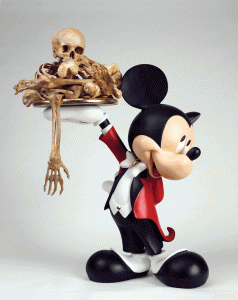« Reviews
Eva and Franco Mattes: I’m Not Here

Eva and Franco Mattes aka 0100101110101101.ORG, MMMM, 2008. Resin, metal, plastic, paint, pigments, 35.4” x 23” x 39”. Courtesy Fabio Paris Art Gallery, Brescia
Fabio Paris Art Gallery - Brescia, Italy
October 3 - November 15, 2009
By Domenico Quaranta
At the entrance, Mickey Mouse welcomes us, one hand beckoning at the exhibition, the other holding a golden plate with a skeleton on it. “I’m not what I seem,” MMMM (2008) seems to say; also, “reality and fiction always go arm in arm,” and last but not least, “there is a skeleton in all the other works.”
Of course, the trick is to find it. Only apparently discontinuous, the work of Eva and Franco Mattes - also known as 0100101110101101.org - has revolved, since its inception, around the concepts of identity, authenticity and appropriation. Among the artists who began their activity online in the mid-nineties, they are probably the only ones who were able to bring to the art audience the big issues of the digital age: Where does copyright go in the age of bits? What does “privacy” mean when surveillance becomes ubiquitous, and “identity” when it can be turned into a string of data, or a polygonal puppet? They started in 1998, for over a year impersonating the Holy See on the Web (Vaticano.org), creating a fake artist and bringing him into the Venice Biennale (Darko Maver), copying and remixing websites and finally spreading a computer virus as a work of art (Biennale.py, 2001). They challenged the materiality of the artwork in such a way that some projects are still almost impossible to put on display: How can one exhibit Life Sharing (2001 - 2003), a three-year long performance sponsored by the Walker Art Center, in which the artists made the entire content of their computer available online?
But do not worry. Even if it does not want to be a retrospective, “I’m Not Here” collects a huge amount of work, including many pieces never shown in Italy or elsewhere. Furthermore, in the monograph recently published by Charta, you will find what is left. The exhibition draws a line that goes from early works to the big media hacks organized between 2003 and 2005, Nikeground (a fake marketing campaign that made the Viennese believe that Nike was ready to put its corporate hands on their beloved Karlsplatz square) and United We Stand (the promotion of a non-existent movie in which the EU saves the world from a war); and from there to their last projects, including their seminal re-staging of infamous performances on the virtual stage of Second Life (Synthetic Performances, 2008).
If we follow them along this path, it is difficult to say whether It’s always six o’clock (2008), the cycle including MMMM, introduces a new phase or is simply translating their concerns in new, apparently more traditional forms. Probably they do both, rearranging fictional characters from different narratives in new, surreal stories.
Domenico Quaranta is an art critic and curator based in Italy. He has focused his research on the impact of the current techno-social developments on the arts.
Filed Under: Reviews


































